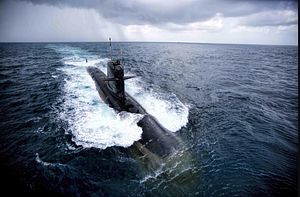The Indian Navy is slated to commission the lead boat of its new class of diesel-electric attack submarines in August, following almost four years of delay.
The induction of the first Scorpene-class (Kalvari-class) diesel-electric attack submarine, INS Kalvari, will mark a significant milestone in India’s efforts to rebuild its depleted submarine force as China and Pakistan are building up their underwater warfare capabilities. As Chinese submarines in particular have stepped up patrols in the Indian Ocean, the Indian Navy’s fleet of diesel-electric subs currently consists of 13 aging boats in various states of operational readiness.
The commissioning of the lead boat of the Indian Navy’s new attack submarine class in the next few weeks follows prolonged sea and weapons trials, including the test firing of a German SeaHake torpedo and the launch of a French-made Exocet SM39 anti-ship missile this year. The Exocet SM39 is a sea-skimming, subsonic, solid-fueled anti-ship missile with an approximate operational range of 50-70 kilometers depending on the variant.
However, the INS Kalvari is still without its primary weapon system against enemy subs and surface warships, given the cancellation of a contract for Black Shark heavyweight torpedos, built by Whitehead Alenia Systemi Subacquei (WASS), a subsidiary of Italian arms manufacturer Finmeccanica. The deal was called off due to corruption allegations.
“The Black Shark torpedo was specifically purchased for the Indian Navy’s future fleet of six Scorpene-class (Kalvari-class) diesel-electric attack submarines,” I reported elsewhere. “A second batch of 49 Black Shark torpedoes was also to be installed aboard India’s domestically developed and built Arihant-class of nuclear-powered ballistic missile submarines.” Alternatives to the Black Shark torpedo include the German-made SeaHake heavyweight torpedo and France’s F21 Artemis.
The 1,550-ton Kalvari-class submarine is equipped with six 533-millimeter torpedo tubes for launching anti-ship torpedoes, anti-ship missiles, and sea mines. According to some reports, the Kalvari is currently not fitted with an air-independent propulsion (AIP) system. Navy officials, however, have stated that AIP could be added at a later stage during retrofit. In fact, it now appears that none of the six Kalvari-class subs will be commissioned with AIP.
French shipbuilder Direction des Constructions Navales Services (DCNS) was awarded a $4.16 billion contract (known as Project 75-I) to build six diesel electric attack submarines for the Indian Navy in in cooperation with MDL in 2005. The initial Project 75-I contract also included the option of building six additional Scorpene-class submarines at MDL.
However, the Indian Navy has recently issued a request-for-information to six foreign manufacturers for a new $8 billion contract to build six submarines with AIP technology, The Diplomat reported last month. The shortlist of manufacturers also includes DCNS; however, the company is unlikely to be selected following an embarrassing data leak (See: “India Drops Plans to Add 3 More French Stealth Attack Submarines”).
The second Kalvari-class diesel-electric attack submarine, christened Khanderi, kicked off sea trials last month and is expected to be commissioned by the end of the year. The remaining four boats will all be delivered by 2020 at an interval of nine months.
































